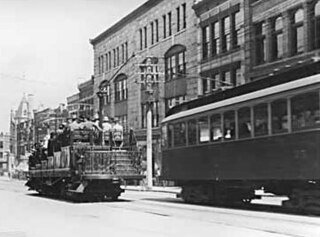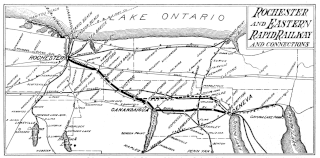
The New York Central Railroad was a railroad primarily operating in the Great Lakes and Mid-Atlantic regions of the United States. The railroad primarily connected greater New York and Boston in the east with Chicago and St. Louis in the Midwest, along with the intermediate cities of Albany, Buffalo, Cleveland, Cincinnati, Detroit, Rochester and Syracuse. New York Central was headquartered in New York City's New York Central Building, adjacent to its largest station, Grand Central Terminal.

The British Columbia Electric Railway (BCER) was an historic railway which operated in southwestern British Columbia, Canada. Originally the parent company for, and later a division of, BC Electric Company, the BCER assumed control of existing streetcar and interurban lines in southwestern British Columbia in 1897, and operated the electric railway systems in the region until the last interurban service was discontinued in 1958. During and after the streetcar era, BC Electric also ran bus and trolleybus systems in Greater Vancouver and bus service in Greater Victoria; these systems subsequently became part of BC Transit, and the routes in Greater Vancouver eventually came under the control of TransLink. Trolley buses still run in the City of Vancouver with one line extending into Burnaby.

The Rochester Industrial and Rapid Transit Railway, more commonly known as the Rochester subway, was a light rail rapid transit line in the city of Rochester, New York, from 1927 to 1956. The subway was constructed in the bed of the old Erie Canal, which allowed the route to be grade-separated for its entire length. Two miles (3.2 km) of the route through downtown were constructed in a cut-and-cover tunnel that became Broad Street, and the only underground portion of the subway. The Rochester Subway was designed to reduce interurban traffic on city streets, and to facilitate freight interchange between the railroads. The line was operated on a contract basis by New York State Railways until Rochester Transit Corporation (RTC) took over in 1938. The last day of passenger service was June 30, 1956. Portions of the right-of-way were used for expressway construction, while the rest was abandoned and filled in over the years. The largest remaining section is a stretch of tunnel under Broad Street from Exchange Street to the intersection of Court Street and South Avenue.
The Elmira and Lake Ontario Railroad was a subsidiary of the Northern Central Railway and later the Pennsylvania Railroad, formed to give the Northern Central an outlet for coal traffic on Lake Ontario.

The Milwaukee Electric Railway and Light Company, also referred to as the Milwaukee Interurban Lines or TMER&L, is a defunct railroad that operated in and around Milwaukee, Wisconsin. It was the largest electric railway and electric utility system in Wisconsin, and combined several of the earlier horsecar, steam dummy, and streetcar lines into one system. Its Milwaukee streetcar lines soon ran on most major streets and served most areas of the city. The interurban lines reached throughout southeastern Wisconsin. TMER&L also operated the streetcar lines in Appleton, Kenosha, and Racine, as well as its own switching operations at the Port Washington and Lakeside power plants.

The International Railway Company (IRC) was a transportation company formed in a 1902 merger between several Buffalo-area interurban and street railways. The city railways that merged were the West Side Street Railway, the Crosstown Street Railway and the Buffalo Traction Company. The suburban railroads that merged included the Buffalo & Niagara Electric Street Railway, and its subsidiary the Buffalo, Lockport & Olcott Beach Railway; the Buffalo, Depew & Lancaster Railway; and the Niagara Falls Park & River Railway. Later the IRC acquired the Niagara Gorge Railroad (NGRR) as a subsidiary, which was sold in 1924 to the Niagara Falls Power Company. The NGRR also leased the Lewiston & Youngstown Frontier Railroad.

The Third Avenue Railway System (TARS), founded 1852, was a streetcar system serving the New York City boroughs of Manhattan and the Bronx along with lower Westchester County. For a brief period of time, TARS also operated the Steinway Lines in Long Island City.
The Railroad industry in Syracuse, New York got its start in October 1831 when a convention held in the city marked one of the earliest moves to stimulate the era of railroad building which ultimately brought steam railroad service to New York State.
The Syracuse Rapid Transit Railway, an interurban railroad, was chartered on May 21, 1896. The company was a consolidation of the Syracuse Street Railroad Company, the Syracuse Consolidated Street Railway Company and the People's Railroad Company which was formerly leased to the Syracuse Street Railroad Company.
The Rochester, Lockport and Buffalo Railroad was an electric interurban railway that was constructed between Rochester, New York, and Lockport, New York, connecting to the International Railway Co. at Lockport for service into Buffalo. Opened in 1909 as the Buffalo, Lockport and Rochester Railway, the route followed the Erie Canal and the New York Central Railroad's Falls Road branch for most of its length. For a brief period of time, the railway was part of the Beebe Syndicate of affiliated interurban railways stretching from Syracuse to Buffalo. Entering receivership in 1917, it was reorganized as the Rochester, Lockport and Buffalo Railroad in 1919. After years of struggling with declining revenue during the Depression years, the railway's last day of service was April 30, 1931.
The Beebe Syndicate was the name given to a group of electric streetcar and interurban railroads as well as construction and finance companies that shared common management based in Syracuse, New York. Founder Clifford D. Beebe (1866–1937) had returned to New York State after building up his career in the banking industry in Michigan. His first involvement with managing electric railways was presiding over the Syracuse and East Side Railway in 1894. After several years of involvement with various local streetcar lines, Beebe turned his attention to the development of electric interurban railways. Beginning in 1899, the Beebe Syndicate grew to control 28 individual companies at its height in 1915. By this time, many properties were placed in receivership due to overwhelming debt. Large parts of the Syndicate were sold into foreclosure in 1917, with the remaining lines reorganized independently. Beebe left the Syracuse area in 1919 and moved to New York City to pursue a career in real estate. He returned to Kalamazoo, Michigan, in 1935 and died of a sudden heart attack in 1937.
The Rochester Railway Company operated a streetcar transit system throughout the city of Rochester from 1890 until its acquisition by Rochester Transit Corp. in 1938. Formed by a group of Pittsburgh investors, the Rochester Railway Company purchased the Rochester City & Brighton Railroad in 1890, followed by a lease of the Rochester Electric Railway in 1894. The Rochester and Suburban Railway was leased in 1905, extending the system's reach to Irondequoit and Sea Breeze. Rochester Railways was acquired by the Mohawk Valley Company, a subsidiary of the New York Central Railroad set up to take control of electric railways in its territory. In 1909 the holdings of the Mohawk Valley Company were consolidated as the New York State Railways.
Rochester Transit Corporation (RTC) was a privately owned, for-profit transit company that operated streetcar, rail, and bus transit in the city of Rochester and surrounding suburban areas from 1938 until 1968. The city-owned Rochester Subway was operated by RTC on a contract basis from 1938 until 1957. John F. Uffert and William A. Lang served as presidents during the course of operation.
The former Syracuse Lines of New York State Railways were reorganized on November 22, 1939, as the Syracuse Transit Corporation (STC). This privately owned transit company inherited 27 transit routes serving the city and suburbs of Syracuse, seven of which were streetcar lines. By 1941, all lines had been converted to bus operation. All STC transit franchises were purchased by the public Central New York Regional Transportation Authority in 1972, continuing their operation as CNY Centro.
Chartered in 1886, the Canandaigua Street Railroad was a local streetcar line serving the lakeside city of Canandaigua, New York beginning in 1887. The railroad was sold to the Canandaigua Electric Light and Railroad which rebuilt and electrified the line in 1892. The Ontario Light and Traction Company purchased it in 1900, and leased the line to the Rochester and Eastern Rapid Railway in 1903. In 1905, the line came under the control of the Mohawk Valley Company, and in turn, New York State Railways in 1909. Operation was converted to bus operation some time in the 1920s, but this service ended when the Rochester and Eastern Rapid Railway shut down on July 31, 1930. The lease of the former Canandaiua lines was allowed to lapse.

The Rochester and Eastern Rapid Railway (R&ER) was an electric interurban railway in New York State, USA, connecting Rochester, Canandaigua, and Geneva.
The Utica and Mohawk Valley Railway was the result of the unification of all city and suburban streetcar lines serving Utica, New York, on November 27, 1901. The railway operated city streetcar service as well as a double-track interurban railway between Rome and Little Falls via Utica. The Utica and Mohawk Valley Railway was merged into New York State Railways in 1912. At its peak, the Utica Lines consisted of 17 transit routes operated with more than 100 cars. The line ceased operation in 1933, except for the section between Utica and Whitesboro that survived until 1938. The last city streetcars operated on May 31, 1941. The remaining transit routes were operated with buses and the franchise would be reorganized as the Utica Transit Corporation in 1948.

The Rochester and Sodus Bay Railway was an electric interurban railway connecting Rochester with the shores of Lake Ontario at Sodus Point. The line was leased to the Rochester Railway Company in 1902 and later merged into New York State Railways in 1909. Ridership dropped off in the 1920s, and the railway east of Glen Haven was abandoned in 1929. The remaining local streetcar service ended in 1933.
The Newark and Marion Railway operated between Newark, New York, and Marion, New York. Chartered in 1900, it opened for business in 1906. The railroad was constructed by the Beebe Syndicate, a conglomeration of streetcar and interurban lines across New York State, though the Newark and Marion was never electrified. The company entered receivership in 1915, and control by the Beebe Syndicate ended. The railroad was reorganized as the Marion Railway Corporation in 1917. The Pennsylvania Railroad acquired the line in 1930. It continued to operate as a spur of the Elmira Branch through the Penn Central and Conrail eras. Operation passed to short line Ontario Midland Railroad in 1979. Dwindling freight traffic and deteriorating track conditions led to the line's closure in July 1984.











